Interviewee: Kelly Mathews, MD Student, University of British Columbia Authors/Editors: Romina Garcia de leon, Shayda Swann (Blog Co-coordinators).
Published: May 5th, 2023
Could you briefly explain what your research is about?
I’m part of a study on healthy aging in women living with and without HIV called BCC3. It involves community members, so women living with HIV, right from the beginning. My project, in particular, is looking at sexual pleasure in women living with and without HIV, and examining if the hormone testosterone has any influence on pleasure. We also look at social variables like income, mental health, home environment, substance use, etc. to see if they have any influence on sexual health.
Why do we need more work to understand sexual pleasure in women?
HIV is not transmissible by sexual activity for people on effective antiretroviral therapy. Yet, research looking at sexual health for women living with HIV has been really pathologizing, seeing women as vectors of disease rather than sexual beings who are deserving of pleasure and satisfaction in their sex lives.
Historically, the way we've studied female sexual function has been thinking that women operate in the exact same way as men do. There's been a ton of research on the sexual response cycle in men and this has been broadly applied to women. This doesn’t take into account how women experience pleasure and what sexual interactions are like for women. For instance, women living with HIV, have often been labeled as having sexual desire disorder, without taking into account structural factors that might be preventing them from wanting to have sex.
I think it's really important to emphasize these positive aspects of sexuality and the other things that give women pleasure, whether that be with a partner or on their own, and once we can figure it out then we can promote it on the frontlines to clinicians, community workers, and among community members themselves.
Recent research suggests that a focus on pleasure can actually lead to safer sex and a reduction in chronic pain, mental health, and fatigue. So I think focusing on pleasure is really the way going forward.
Could you highlight some important findings from your research?
The biggest thing that we've seen so far in preliminary results is that there's actually no difference in the prevalence of reporting ‘always’ or ‘usually’ experiencing pleasure during a sexual experience when we compare the women living with HIV and those without HIV, which was a bit of a surprise! This is something that we hope will be empowering for community members to take away from the study. We also acknowledge that it’s important to keep promoting pleasure for more people because only 60-65% of the women in our study reported ‘always’ or ‘usually’ experiencing pleasure.
I think that this finding highlights some of the strengths of our study. We looked at pleasure not only in partnered sex, but also for women who are engaging in self-pleasure/masturbation. Not too many projects have done that in the past. I think another strength is that our control population is very similar in terms of many sociostructural factors such as housing, income, and substance use to the women living with HIV in our study. So this helps us narrow in on this pleasure piece and shows that the virus itself isn't changing pleasure. It's more of those social determinants of health that affect both populations.
Another important finding was that women living with HIV have lower total testosterone levels than HIV-negative women, but this was not associated with an increased or decreased odds of pleasure.
What other questions do you hope to answer next?
We’ve nearly doubled our sample size of women that we have testosterone measurements for and sexual pleasure responses. That’s going to allow us to look at a few more variables and, in particular, it's going to allow us to do an analysis stratified by HIV status. Having spoken to some community members, a lot of people have highlighted the need for including chronic pain as well as maybe HIV medication side effects in our analysis. It would also be really interesting to look at how HIV factors like immune cell count, HIV viral load, and HIV-related stigma might impact sexual health.
What impact do you hope to see with this work years from now?
I think the community involvement and the design of the BCC3 study are really good and I hope that more projects will emulate that in the future and have more community members involved in every step of the project. In terms of pleasure, I really hope that there is a shift to conducting more research focusing on these positive aspects of sexuality.
Another hope is that we can get the message out about U Equals U and reduce the stigma surrounding HIV. U Equals U, or undetectable equals untransmittable, is a saying from groundbreaking research that essentially means that there is no risk of transmitting HIV to a sexual partner if the person living with HIV is using effective HIV medication. Knowing this, my goal for the future is that more and more women living with HIV will be able to experience stigma-free sex and have the same opportunities for a satisfying sex life as someone that doesn't have HIV.
